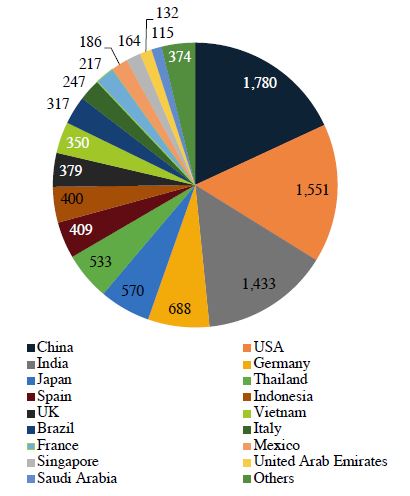
By Mingze Li, Zhaoyu Zhu, Vani van Nielen, Larina Maira Laube, Eliana Levine, and Paloma Guerra
Does the leisure and tourism workforce need to be rescued? Considering the industry contributes 10.4% of global GDP, supporting one in ten jobs on the planet, we can affirm that the tourism industry is one of the principal job providers.
Business recovery is expected to be slow. The United Nationa World Tourism Organisation (UNWTO) has estimated a 20%-30% global decline in international tourist arrivals. Major hotel chains are reducing their workforce. The business is performing 50% below normal levels in the European market and Asia Pacific, excluding China. Marriott International CEO Arne Sorenson said that the hotel’s business was running almost 75% below normal levels. This is the reason behind Marriott’s decision to cut off two-thirds of its 4,000 corporate employees at its Bethesda, Maryland head office, which means approximately two-thirds of corporate staff abroad will also be furloughed. All the way down to the hotel operation level, international brands are facing the critical issue of redundancy during this current COVID-19 crisis, regardless of each owner’s specific cash flow situation.

What are your underlying drivers for retention or downsizing strategies?
This article will navigate through the upsides and the downsides of these two strategies – retention or downsizing. We will provide you with examples and reflections that you may find useful to evaluate your best actions.
The underlying variables of the post-COVID-19 business plan are related to economic and governmental policies, and they are not consistent worldwide. Therefore, in this document, we are not going to provide our opinion nor recommendations. Nevertheless, our hotel asset management team can provide best practices and adapted approaches to each particular hotel.

STRATEGY ONE: TO AVOID COVID-19 LAYOFFS
PRO: Instilling Loyalty Among Your Staff
The corporate value of international hotel brands includes the relevant element of employee caring. For example, Marriott states that they put people first, and its motto is ‘Take care of our associates and they will take care of our customers’.
Besides the written contract, the hotel chains have built psychological contracts with their employees which creates unwritten expectations in the employment relationship. As such, the handling of employee-related issues would determine if the psychological contract is perceived as being kept or breached. The breach can severely damage the motivation and performance of the staff. In this hyper-connected world, information about mishandling labour-related issues could be quickly propagated and damage the employer branding of the hotel chains. However, it could be an opportunity for hotel chains to show they care for the well-being of their employees.
For instance, Hilton has announced it will team up with 30 leading companies to provide temporary jobs, in addition to the common practice of covering health benefits. Furthermore, Accor will allocate EUR70 million in a fund to cover those employees without medical insurance or social security that present with COVID-19 health issues and to support front-line healthcare professionals and non-profit organizations. The fund is raised from the unpaid year 2019 shareholder dividends.
The determination to maintain a positive attitude towards staff caring and experience throughout the crisis is crucial for the recovery phase. There is no doubt that the different hotel brands will restart the competition for the talents in the industry once the market starts to recover, and good employer branding can be a competitive edge. Besides employees do not forget when you support them during tough periods.

CON: Adding Substantial Pressure to Your Cash Flow
When occupancy is plummeting to single digits, cash flow management has become the lifeline of nearly all the hotels. As labour cost regardless of the hotel category generally represent the largest component of operational expenses, multiple hotel chains including Marriott, Hilton, Hyatt, Accor, and MGM have announced furloughing schemes as a component of their COVID-19 responses, to slash costs. Furthermore, these hotel chains have also declared a different degree of pay cuts for the remaining employees. For example, CEOs put a halt to cash dividends and reduced salaries to senior executive teams by 50%. The cost-saving exercise should be conducted in a way that allows the hotel to recover quickly once the demand comes back.
A salary cut policy is required at every level to survive. In other words, we all need to tighten our belts until the ramp-up stage. The significance is that, if the termination of the employment contract is not an option, some businesses may be only left with one choice – a total shut down. When planning different financial scenarios, it is essential to manage the working capital for the short and medium-term. Owners need to start pro-active discussions with their banks or other investors to increase their debt service.
On the 28th of March, the Wujiang Hotel Chain, an emerging hotel chain formed under the investment of C-Trip last year, was the first hotel chain to collapse in this crisis. Wujiang Chief Executive, Xiaodong Ma, has announced they will terminate all employment contracts by the 30th of April. There is no doubt that the ban on unilateral termination of employment contracts in China during the lockdown has greatly contributed to the downfall of this one-year-old hotel chain.

STRATEGY TWO: TO EXECUTE COVID-19 LAYOFFS
PRO: Team optimisation and transformation
The drastic drop in business has forced many hotels into a minimum level of operation. At the same time, the crisis has made it easier for the operators to identify who are the core staff, and who are the weaker team players. We all know that layoffs are necessary and open up an opportunity to review the organisation to optimise productivity, reduce long term costs, and often improve the overall operation/guest experience.
In addition, the human resources department should optimise the workforce according to several variables that will impact the labour cost structure:
# Adjust the business plan with several tentative re-opening dates.
# Adapt the workforce to different ramp-up occupancy level.
# Reorganise the F&B team to the gradual opening of the various outlets (same applies to other operating departments).
# The wellbeing of employees – motivation, training (e.g. new hygiene procedures) and reassure the team after this challenging period.

CON: Consideration of recruitment, retraining costs and reputation
As China’s economy is slowly shifting towards recovery mode, many labour-intensive companies, including hotels, have found themselves short of workers. The reason for this labour shortage varies, but one of the reasons was that some employees were reluctant to return for fear of infection.
Since 2016, many industry analysts have been expressing concerns over a labour shortage at all levels, especially in the operational departments. This phenomenon is highly detrimental to the industry, as hotel operations require a set of expertise in every department. The labour shortage can be statistically proven by the increasing labour cost percentage at hotels.
Also, other than payroll, there is a key factor that justifies the value of raising the labour costs, this is training. When hotel management executes a training plan for different levels of staff, costs included in this are the training materials, supplies, certification programs, and instructor fees. Thorough training will have a direct positive impact on productivity, customer satisfaction, revenue growth through upselling, and enhance employee satisfaction that leads to lower turnover.
It is logical to interpret similar situations that would occur in other sectors in the recovery phase. Keeping the current staff may be a sound strategy for minimising the cost of rehiring. As hotels in China rely on the domestic labour force, it can be estimated that the increase in hiring cost after the crisis can be even steeper for countries mainly relying on foreign labour. Last but not least, owners and operators should consider that downsizing has a reputational risk, especially if the crisis is short.
Before making any decision, it is important to consider the following: What are the hotel’s core values? How do owners and operators want to be recognised in the market? How will this impact in the recovery period? The list of pros and cons of each strategy seems to be limitless, and we are only listing out the general considerations. As such, please do not hesitate to share with us your thoughts and considerations on your staff retention and downsizing strategies.
This article was provided by Global Asset Solutions and republished with permission. To read the source version, including source references, please CLICK HERE.

